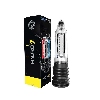No products
Andropause: causes, symptoms and treatments
Published : 2025-02-24 16:39:16
Categories :

Andropause: causes, symptoms and treatments
It is very likely that you have already heard about menopause, which affects all women over the age of 50. However, there are few who approach the disorder with similar consequences that affects males and that manifests itself by the age of 60. Andropause, as it is called, is similar to menopause but in men. It is important to know what it is, how to identify it and what to do.
Unlike women, for whom menopause is more noticeable, andropause is a slow and prolonged process, so it is more difficult to identify. It is important to pay attention to tests, as many symptoms are very similar to those of other diseases. The symptoms of andropause are:
- Lack of energy, excessive tiredness and mood swings (irritability, distress, frequent sadness)
- Sweats and hot flashes
- Decreased or loss of sexual desire
- Decreased ability to erection
- Absence of spontaneous morning or night erections
- Loss of bone and muscle mass
- Difficulty concentrating and memory problems
- Increased visceral (belly) fat
- Dry skin;
- Anemia;
- Hair loss and/or reduced beard growth
- Reduction of body hair.
Causes
Diabetes, obesity, metabolic diseases such as high cholesterol, fatty liver and osteoporosis can increase your chances of experiencing andropause. Smoking and drinking alcohol are often also causes of andropause.
Andropause, when diagnosed late, can affect quality of life, mental health and even sex life. Therefore, treatment and diagnosis as early as possible is extremely important. We recommend looking for a doctor from the age of 35 for follow-up.
Diagnosis of Andropause
The diagnosis of andropause is made through a blood test, semen analysis, bone densitometry and a digital rectal exam. The blood test is responsible for measuring the amount of testosterone. The spermogram is responsible for quantifying sperm production.
Treatment
Andropause symptoms can be alleviated or lessened with some care. With a balanced diet, controlled exercise and an active sex life, men can help testosterone levels return to normal. Hormone replacement may also be applied in some cases.
Despite this information, the most recommended thing is to make an appointment with your doctor. He can help you understand what you are feeling and minimize your symptoms.
Myths and Truths About Andropause
Many men are aware of these signs and associate them with normal changes that occur with age, causing them to delay making an appointment with a specialist. But, if you have any of these symptoms, only the doctor can make a proper diagnosis and dispel your doubts, as there are many myths associated with andropause. These are the most common myths:
Andropause does not exist.
False. The syndrome can be mild in some cases, but it is real. However, many men deny the problem for lack of information and, at times, for the derogatory component with which the subject is still treated in some circles.
Sexual desire and erections decrease.
Real. With the decrease in the level of testosterone, libido and the number of spontaneous erections (those that occur during sleep, for example) are also reduced. Anyway, it's a slow process, it doesn't happen overnight.
All men over 40 with erectile dysfunction and decreased sexual desire suffer from andropause.
False. Before making any definitive statements, a patient with these symptoms must undergo a specific evaluation to determine the cause of these conditions.
Any man with sexual dysfunction needs testosterone.
False. As in the previous case, a diagnosis must first be made, with the aim of establishing the appropriate treatment. Afterwards, the specialist will tell you whether hormones are a suitable treatment or not.
There are factors that can accelerate andropause.
Real. From the age of 30, normal aging in men causes a 1% drop in testosterone levels. This percentage gradually increases from the age of 45 onwards. However, men with risk factors (diabetes, hypertension, cholesterol, obesity...) will likely notice a greater and more abrupt drop in those levels.
Food helps mitigate the effects of andropause.
True. Sticking to a healthy diet and lifestyle helps maintain energy, muscle mass and strength. It also helps to improve the mood and to rest better.
Andropause is male menopause.
False. In women, the decrease in fertility occurs in a shorter and more concentrated way, while sperm production in men decreases more slowly; therefore, man's reproductive capacity falls little by little.
Emotional disorders may appear.
Real. Low levels of testosterone can cause changes in mood, usually causing a feeling of sadness. Also, the andropause process can cause a lack of confidence in yourself.
Sleep disorders occur.
Real. Hormonal changes can affect sleep patterns (either insomnia or a feeling of continual drowsiness), although it may not be in a serious way. If these changes persist over time, you should consult your doctor.







